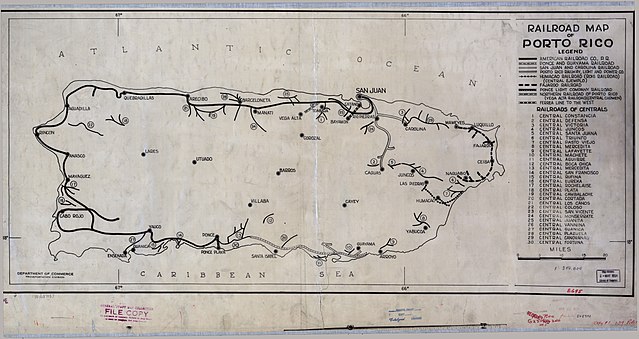Rail transport in Puerto Rico: Difference between revisions - Wikipedia
 Article Images
Article Images
Content deleted Content added
The Eloquent Peasant 154,597 edits |
|||
| (5 intermediate revisions by 5 users not shown) | |||
Line 1: {{Short description|none}} <!-- "none" is a legitimate description when the title is already adequate; see [[WP:SDNONE]] -->
[[File:Railroad map of PR 1924.jpg|400px|thumb|right|Railroad map of Puerto Rico, 1924.]]
== History == Line 34: Transport by rail greatly improved the everyday life of Puerto Ricans, since passengers could now travel between the largest cities, San Juan and Ponce, in record time.{{Citation needed|date=February 2010}} Previous trips used to take several days by horse and wagons, but the regular train greatly reduced traveling time to around 10 hours. There were four main trains operating all day and night during the system’s peak years, with Train No. 1 departing at 7:00am from San Juan and arriving in Ponce at 5:00pm. Tickets for this one-way trip cost $1.50 for first class and $0.95 for second class in 1950.<ref name="Nostalgia"/> The system was such an important part of island society, that famed composer [[Manuel “Canario” Jimenez]] composed a ''[[Plena]]'' song titled ''La Máquina'' (The Machine) about the daily trip between San Juan and Ponce.{{Citation needed|date=February 2010}} === Tragedy on election day in 1944 === On the early morning hours of November 7, 1944, the [[American Railroad Company of Puerto Rico]] suffered the most violent accident in its history.<ref name="endi">[http://www.rootsweb.com/~prsanjua/tren.htm ''La Tragedia del 7 de noviembre de 1944''] {{webarchive|url=https://web.archive.org/web/20070324184501/http://www.rootsweb.com/~prsanjua/tren.htm |date=2007-03-24 }} (The Tragedy of November 7, 1944) by Haydee E. Reichard de Cancio, [[El Nuevo Dia]], Por Dentro Section, Pg. 116, December 7, 1996, retrieved on July 31, 2006 {{in lang|es}}</ref> Train No. 3 was traveling from San Juan to Ponce carrying passengers to their different hometowns for the island general elections to be held that same day. It stopped at the Jimenez Station in Aguadilla for a routine [[Railroad engineer|engineer]] and fireman exchange with Train No. 4 which was heading towards San Juan. The engineer assigned to Train No. 3's ride from Jimenez Station to Ponce was Jose Antonio Roman, an experienced freight train engineer, but who had never worked in passenger travel.<ref name="endi"/> When the train left the station at 2:00am, it was hauling six passenger cars with hundreds of commuters and two freight cars. [[File:Cuesta Vieja, street in Aguadilla, Puerto Rico.jpg|thumb|Cuesta Vieja in Aguadilla]] At 2:20am the train started to descend a hill section known as ''[[Cuesta Vieja]]'' (Old Hill) in Aguadilla at what some witnesses described as an exaggerated speed. When the train reached the leveling-off point at the bottom of the hill it [[Derailment|derailed]]. The steam locomotive crashed into a ditch and one of the freight cars crashed into one of the passenger cars, killing many inside. Witnesses described the scene as horrendous, with some accounts stating that parents were throwing their children out the windows to save them from the wreckage.<ref name="endi"/> Chief of Police Guillermo Arroyo stated that the locomotive (No. 72), the express car, and three second class passenger cars were completely destroyed. Oscar Valle, an Aguadilla correspondent to the local ''[[El Mundo (Puerto Rico)|El Mundo]]'' newspaper, summarized the scene in a more dramatic way: "The locomotive suffered a terrible explosion as it derailed, and the impact was so strong that 3 passenger cars were converted into a fantastic mound of wreckage."<ref name="endi"/> In the end, 16 passengers lost their lives, including the engineer and the fireman, and 50 were injured in the crash.<ref>{{Cite web|url=http://www.eleditor.net/medio-ambiente/puerto-rico-y-aquel-tren-que-nunca-llego-a-destino/|title=Puerto Rico y aquel tren que nunca llegó a destino|language=es}}</ref> ===Downfall=== Line 62 ⟶ 63: {{Main|Tren Urbano}} The Tren Urbano is a heavy-rail commuter metro system serving the cities of Bayamón, [[Guaynabo]] and San Juan. It is the only active rail system serving the general public in Puerto Rico, with 16 stations along a {{convert|10.7|mi|km|1|adj=on}} route. It is [[Railway electrification system|electrified]] by third rail at 750 volts of [[direct current]]. The line's construction started in July 1996 with the purpose of relieving traffic congestion in the San Juan metropolitan area, and was inaugurated January 2005 to mixed reactions. With a final estimated cost of $2.25 billion, nearly $1 billion more than original estimates,<ref name="Tollroadnews">[http://tollroadsnews.info/artman/publish/article_1161.shtml/ ''Tren Urbano PR another way low transit ridership forecast''] {{Webarchive|url=https://web.archive.org/web/20081021101106/http://tollroadsnews.info/artman/publish/article_1161.shtml/ |date=2008-10-21 }}, TOLLROADSNews, November 20, 2005, accessed April 13, 2007.</ref> the project has been criticized by government watchdogs, especially for its low passenger use of approximately 24,000 daily passengers (2005 est.), compared with original projections of 80,000.<ref name="Tollroadnews"/> Upon its inaugural opening, there were initial plans to extend the Tren Urbano rail system to outlying suburbs of the San Juan metro area, including a light interurban rail system [[San Juan-Caguas Rail|from San Juan to Caguas]] originally scheduled to be completed in 2010.<ref>{{cite web| url=http://www.puertorico-herald.org/issues/2004/vol8n15/CBCaguasSanJuan.html| title=Caguas To San Juan In 15 Minutes| access-date=2007-05-08}}</ref> However, these designs have not been finalized and no construction work has commenced yet. The proposed Caguas rail project remains postponed as of September 2019. Line 121 ⟶ 122: {{1944 railway accidents}} [[Category:Rail transport in Puerto Rico| ]] [[Category:Heritage railroads in Puerto Rico]] [[Category:3 ft gauge railways in the United States]] | |||